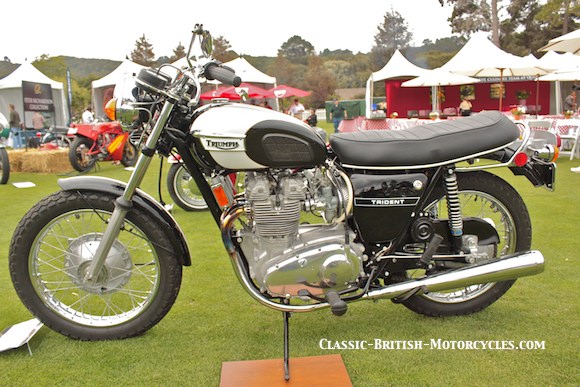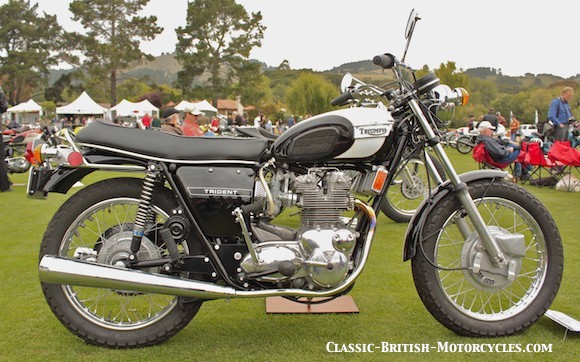1971 Triumph Trident T150
THE 1971 TRIUMPH TRIDENT EVOLVES
After 2 model years since it’s introduction in 1969, the novel Trident triple continued to evolve slowly, both mechanically and stylistically. On the styling front, the restyled 1971 Triumph Trident benefited from all the new cycle gear introduced on the also new and it’s stablemate, the 1971 TR6. Triumph and BSA had just spent a pile of cash redesigning the big 650 Twins, and all this shiny new hardware naturally percolated down (or up, depending upon how you look at it) to the Trident. Just as the 1970 Triumph Trident bore a strong family resemblance to the 1970 Bonneville, this new 1971 Triumph Trident also looked very much like the 1971 Bonneville and TR6 twins.
STYLING THE 1971 TRIUMPH TRIDENT
Most obvious right off are the conical brake hubs front and rear. While these hubs look exotic, and happen to be among my personal favorite, from a purely esthetic point of view, they never stopped as well as the 8-inch full-width TLS (Twin Leading Shoe) front brake and 7-inch SLS (Single Leading Shoe) rear brake they replaced. Those brakes came straight off the 1968-to-1970 Triumph Bonneville that were used on the 1969 and 1970 Tridents, and they did a good job of hauling down the heavier, more powerful Trident and BSA Rocket 3. Unfortunately, the same cannot be said for the conical hubs that arrived in 1971. But they looked good, and sometimes that’s good enough. The 1971 Triumph Trident also received the new front forks with exposed stanchions and aluminum sliders, and those slender tapered megaphone mufflers from the 1971 Triumph Bonneville. A new tank, seat, fenders, head & tail lights, and miscellaneous cycle gear, also from the Triumph twins completed the package. In fact, the only piece of “eye candy” (ie: bodywork) on the whole bike that didn’t come straight from the twins are the side covers. And as you can see, the end result was a handsome motorcycle by anyone’s standards.

MECHANICAL CHANGES ON THE 1971 TRIUMPH TRIDENT
The full raft of 1971 Bonneville/TR6/BSA A65 cycle gear and hardware were applied to the T150 Trident and BSA Rocket 3 and this necessitated a long list of engineering changes and upgrades, some major, some incredibly small, but required nonetheless. The new front forks reduced the Triumph Triple’s wheelbase by a full inch, down to 57 inches. The stylish new side covers had “Trident” transfers (decals) rather than screw-on emblems as before, and no longer covered the air cleaners. The new flat “pancake” headlight had its own rotary switch plus warning lights turn signal indicators, along with the main ignition/light switch. Grab rail, fender mounts, headlight mounts, everything was changed. And after they were all done, they big Triumph triple had lost 8 pounds. Warranty claims resulting from reliability issues (ie: engines blowing up when you ran the crap out of them) triggered a mild detuning of the engine including changing the carburetor slides from 3 to 3-1/2, and a drop in compression ratio to 9:1. These resulted in reduced top speed and an increase in fuel consumption, to an already thirsty bike, now getting only about 35 mpg. Couple that with the 2-3/4 gallon American-market ‘teardrop’ tank, and you couldn’t even go 100 miles without running dry.

1971 TRIUMPH TRIDENT UNLIKED AT HOME
By 1971, Triumph’s parent company, BSA, was quickly unraveling, due to, and amidst cash shortages, rotten management, and prideful politicking. And since all Trident and Rocket 3 engine production was done at BSA’s Small Heath factory, when things got rocky over at BSA, Triumph Trident production virtually stopped. But when they did leak out into the British home market, many Brits disliked them because of their poor fuel economy and small fuel tank, along with their sparse fenders (mudguards in British-speak) and weak brakes. Oh well, the whole re-styling effort was intended for the all-important U.S. market anyway. And again, it succeeded in that department. The 1971 Triumph Trident is a looker.

1971 TRIUMPH TRIDENT ENGINE
On the right side, or “timing-side” of the engine, it’s easy to see the family lineage. Like the twins, there were 2 cams, one in front of, and one behind the cylinder block, driven by a chain of gears off the right end of the rank. Shifting was still on the right, as God intended it. Besides having 3 cylinders instead of 2, the other big difference was that the alternator was moved to this side from the primary-side, hence the large round bulge at the bottom of the timing case, above.
1971 Triumph Trident SPECIFICATIONS
|
Model Designation Engine type Engine configuration Engine displacement Bore & Stroke Compression Ratio Horsepower Ignition type Electrical System Contact Breaker Gap Setting Advance Range Fully Advanced at Carburation Carb type Main Jet size Needle Jet size Needle type Needle position Primary Drive Clutch Gearbox Shifting Shift Pattern Gearbox Internal Ratios: 4th 3rd 2nd 1st Overall Ratios: 4th 3rd 2nd 1st Final Drive: Gearbox Sprocket Wheelbase Overall Length Overall Width Overall Height Ground Clearance Seat Height Unladen Weight Engine Weight Engine Lubrication Front Suspension Rear Suspension Front Brake Rear Brake Front Tire size Front Tire type Rear Tire size Rear Tire type |
T150 4-stroke, air-cooled traverse inline 3-cylinder 741cc / 45ci 67mm X 70mm 9.0:1 58hp @ 7,250rpm Ponts & Coils 12 volts DC .014-.016″ / .35-.40mm 12 degrees / 24 degrees 2,200rpm 3-Amal 26mm Concentrics Amal Mk I 150 106 STD 2 triple-row chain single-plate dry, diaphram 4-speed constant mesh right foot
1-down, 3-up 1.00:1 1.26:1 1.71:1
2.47:1 5.26:1 6.64:1 9.00:1 13.00:1 18 teeth 57in / 144.78cm 86in / 218.44cm 33in / 81.28cm 43.5in / 100.49cm 6.5in / 16.51cm 32in / 81.28cm 460 lbs / 208.0 kg 180 lbs / 81.72 kg dry sump telescopic, hydraulic swing arm, 2 dampers 8-inch TLS drum, conical 7-inch SLS drum, conical 3.25 X 19″ Dunlop TT100 4.10 X 19″ Dunlop TT100 |


